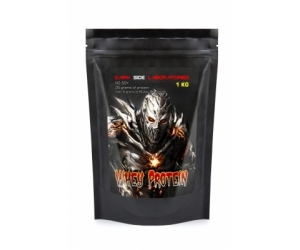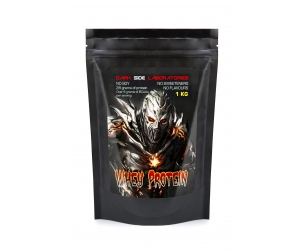Which protein is better? Assessment of the quality of food proteins.

2023-06-26 Author: DarkSideLaboratories Reading time: 10 min
Table of content
Proteins (proteins). The general concept.
Complete and incomplete proteins.
"Reference protein".
Methods for assessing the quality of food proteins.
The amino acid with the smallest amino acid number is called "limiting".
When I started working on the article, I was well aware that not everyone would read it to the end and understand the formulas and tables used. Nevertheless, having understood the material, you will clearly understand what are the advantages / disadvantages of the type of protein you are interested in and, based on your goals, you will be able to make an informed choice based on mathematical calculations. I have tried to adapt the presented material as much as possible for understanding the average reader. How did I do it? You will answer this question yourself. In any case, to the next question: Denis, which protein is better? I'll be able to drop the link to the article.
Proteins (proteins). The general concept.
Proteins (proteins) are organic high–molecular nitrogen-containing compounds, the structural units of which are amino acids connected in a chain by a peptide bond.
Proteins are the material basis of life, because they are found in almost all human organs and tissues. Their main function is plastic (structural) and catalytic. In addition, proteins perform transport, regulatory, protective, receptor, contractile and reserve functions.
All tissues of the human body (nervous, epithelial, muscular, connective) consist of proteins.
Entering the body with food, proteins break down into amino acids, from which, in turn, proteins characteristic of our body are synthesized.
(!) Proteins – consist of amino acids.
(!) The main role of proteins in nutrition is to provide the body with the necessary amino acids.
By the way, did you know that adipose tissue is a kind of connective tissue? The next time your friends call you fat, you can safely answer that there is simply too much connective tissue in your body. Technically, you'll be right.
Amino acids.
In the context of assessing the quality of food proteins, we will talk about proteinogenic amino acids. There are about 500 different amino acids in the world. Proteinogenic (protein–creating) amino acids are 20 amino acids from which the body synthesizes its own proteins. It is on them that we will focus our attention. For example, taurine is not a proteinogenic amino acid. It does not take part in the construction of proteins, but plays an important role in fat metabolism and acts as an inhibitory neurotransmitter of the central nervous system.
There is a complex classification of amino acids. We are interested in the division into interchangeable, irreplaceable and conditionally irreplaceable. (Table 1)
Essential amino acids cannot be synthesized in the body. To synthesize their own proteins, they must be obtained from food.
Conditionally essential amino acids are amino acids that the body is able to synthesize independently, except for periods when the metabolic pathways of their synthesis are insufficiently developed or disrupted. Synthesis disorders can be caused by various diseases or age. For example: children under 3 months need cysteine, at this age it is not synthesized in them. For patients with phenylketonuria, tyrosine is an essential amino acid, since the reaction of tyrosine synthesis from phenylalanine does not occur in persons with this ailment. With injuries, severe stress, infectious diseases, the need for arginine and glutamine sharply increases. During such periods, the body is not able to synthesize these amino acids in sufficient quantities.
Interchangeable amino acids – can be synthesized in the body from organic precursors.
(!) Essential amino acids are not synthesized in the body.
(!) Interchangeable amino acids are synthesized in the body.
(!) Conditionally essential amino acids are synthesized in the body, but not always.
By the way, did you know that taurine is an essential amino acid for cats? Choose foods for your pets that are additionally enriched with taurine. Due to the peculiarities of the enzymatic system, the body of cats cannot synthesize taurine from cysteine, which can lead to vision problems and cardiomyopathy.
Complete and incomplete proteins.
The proteins obtained with food differ in the content of essential amino acids and amino acid composition. In this regard, proteins are divided into full and incomplete.
A full-fledged protein is considered if it contains all the essential amino acids in the amount necessary to meet the plastic needs of the body. Animal proteins (meat, fish, eggs, milk proteins) are classified as full-fledged proteins. They contain all the essential amino acids and have high nutritional value. Their amino acid composition is close to the amino acid composition of human proteins.
An inferior protein is considered if it does not contain or contains in an extremely small amount at least one essential amino acid. As a rule, vegetable proteins are defective. They have low nutritional value. They lack lysine, threonine, tryptophan. The exception is the proteins of legume seeds (beans). They contain lysine, threonine and tryptophan in sufficient quantities, but they are depleted of sulfur-containing amino acids (methionine, cysteine). In contrast, the proteins of cereals (corn, rice) contain a sufficient amount of sulfur-containing amino acids, but there are not enough deficient lysine, tryptophan and threonine. Thus, the combination of legume and cereal seed proteins improves the total balance of amino acids and in the mixture approaches full-fledged animal proteins.
In the absence of an interchangeable amino acid in the composition of dietary protein, the body synthesizes it from other substances (organic precursors), thus supplementing the full set of amino acids necessary to build its own protein. In the absence of at least one essential amino acid, protein synthesis stops. Protein synthesis requires all 20 proteinogenic amino acids.
(!) A complete protein contains all the essential amino acids. Defective protein – at least one essential amino acid is missing in the composition, or it contains extremely little.
(!) A great option for vegans would be to combine beans with corn/rice. Another good option: a combination of pea and oat proteins in a ratio of 1:1
"Reference protein".
The nutritional value of a protein cannot be determined solely based on the presence/absence of essential amino acids in it. The amino acid profile of the protein should be balanced: amino acids should be contained in a certain ratio.
Thus, we have come to the concept of "reference protein". This is a theoretical protein, perfectly balanced in amino acid composition. (Table 2)
To determine the quality of any protein under study, a comparison is made with a "reference protein"
(!) "Reference protein" is a theoretical ideal protein for human nutrition.
Methods for assessing the quality of food proteins.
To assess the quality of proteins, various indicators are used: amino acid score, biological value, efficiency coefficient, net utilization, PDCAAS (amino acid score adjusted for protein assimilation). Since 2013, a new method called DIASS has been used. To date, WHO experts call the DIASS methodology "preferably the best".
The amino acid score is an indicator of the ratio of a certain amino acid in the protein under study to the content of the same amino acid in the "reference protein", expressed as a percentage. For each amino acid, the score is calculated separately. The content of methionine and cysteine, phenylalanine and tyrosine is calculated in total.
The amino acid score (AC) is calculated by the formula:
AC = (SNAK issl / SNAK Et) *100%
AC – amino acid score
SNAK issl – amino acid content in 1 g of the studied protein (mg)
SNAK et – the content of the same amino acid in 1 g of the reference protein (mg)
Any of the amino acids in the reference protein is taken as 100% fast. As a result of calculations, the amino acid score of the protein under study may be less than 100%, greater than or equal to 100%. If the score exceeds 100%, then this indicates that the protein under study contains this amino acid in excess. In the case when the score is 100%, this indicates the optimal content of this amino acid for human nutrition. When the score is less than 100%, it means a shortage of this amino acid in the protein.
The amino acid with the smallest amino acid number is called "limiting".
In proteins with low nutritional value, there may be several amino acids with a content of less than 100%. In this case, the amino acid with the smallest amount will be considered the "first limiting".
The limiting amino acid determines the degree of assimilation of the whole protein. This is due to the fact that amino acids coming from food in excess of a relatively limiting one are not able to be stored for the future, they break down during metabolism and are quickly excreted from the body.
For protein synthesis, all proteinogenic amino acids must be present in the body simultaneously in an accessible form and in the required amount. As soon as one of the amino acids "runs out", protein synthesis stops.
Calculation of the amino acid score for whey protein from Dark Side Laboratories. (Table 3)
The biological value of protein. In simple words, this is the degree of protein assimilation. Frequently used synonyms: true digestibility or true percentage of protein use. The biological value of the protein is expressed as a percentage. Animal proteins have a higher biological value. They are absorbed by 90% and higher. The closer the amino acid profile of the protein is to the "reference protein", the more efficiently it is absorbed.
Vegetable proteins are absorbed by 60-80%. They contain cellulose (an indigestible polysaccharide), which interferes with the assimilation of proteins. They have a lower biological value. Heat treatment of food leads to better protein absorption.
There are a number of formulas that allow you to calculate the biological value of a certain type of protein for humans. All of them are based on a comparison of nitrogen obtained and isolated. This is quite difficult-an achievable practical task, so it is customary to determine the biological value of protein in comparison with the easily digestible egg protein.
Featured Supplements
#натуральныйсывороточныйпротеин #натуральныйбелок #naturalwheyprotein #glutenfreewheyprotein #cleanwheyprotein






 Russia, 456440,
Russia, 456440,







